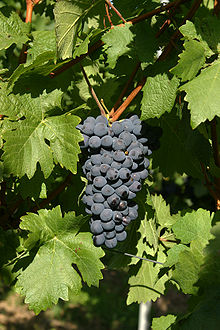Helfensteiner
Helfensteiner is a red wine variety that is also known under the name Blauer Weinsberger . It was created in 1931 by crossing of Frühburgunder and blue Trollinger at the National Training and Research Institute for wine and fruit growing in the vineyard . The variety protection of the new breed was granted in 1960. The breeder of the grape variety is August Herold , who is also considered the breeder of the grape varieties Kerner (1929), Heroldrebe (1929) and Dornfelder (1955). The information provided by the breeder about the parents of the cross has been confirmed by DNA analysis in the meantime.
The name is derived from the Helfenstein Castle near Geislingen . The variety is grown in the Württemberg growing area ; the planted vineyard area is about 25 hectares . The red wines are delicately fruity and pleasing and the rosé wines are of good quality. The low acceptance of the variety among winegrowers is due to the fluctuating yields, which are due to its sensitivity to flowering. Helfensteiner is a variety of the noble grapevine ( Vitis vinifera ). It has hermaphroditic flowers and is therefore self-fruiting. In viticulture , the economic disadvantage of not having to grow male plants that produce yield is avoided.
In the meantime, other breeds have emerged from the Helfensteiner, of which the Dornfelder , a cross with the Heroldrebe , is a great success. The Hegel variety comes from the same parents as the Dornfelder.
See also the article Viticulture in Germany and the list of grape varieties .
- Synonyms : Blauer Weinsberger, breeding number We S 5332
- Parentage : Frühburgunder x Trollinger
Ampelographic varietal characteristics
- The shoot tip is open. It is hairy spiderweb to white wool and of whitish-green color.
- The large to very large, dark green leaves (see also the leaf shape article ) are three-lobed to slightly five-lobed. The stem bay is closed with an overlap. The leaf margin is serrated to a point. Compared to other grape varieties, the teeth are set wide. The leaf surface (also called blade) is blistered.
- The slightly conical to cylindrical grape is large, shouldered and dense berries (depending on the degree of flowering sensitivity, also loose berries!). The slightly rounded, slightly elongated berries are medium-sized and bluish-black in color. The juice of the crisp berries is slightly reddish in color.
Helfensteiner drives medium early to late and does not always avoid late spring frosts. The winter frost resistance is moderately good. The vigorous variety can produce very good yields. However, it tends to be too slow to flower. Generally, however, also applies to Helfensteiner: if the vine is not pruned correctly (→ Vines ), despite Blühempfindlichkeit the risk of high yields with the concomitant reduction in quality. The yield can be as high as 100 hectoliters / hectare.
It often reaches medium-high must weights . On average, the must weight is a few degrees Oechsle above that of the Blauer Portugieser .
The flowering time is late. The Helfensteiner ripens only a few days after the Gutedel and is therefore considered to ripen early. It can be harvested shortly after the Portugieser. The variety is not very sensitive to the false and powdery mildew . Due to the hard berry pods, the variety is hardly susceptible to gray mold rot .
distribution
The vineyards in Germany were distributed among the individual growing areas in 2007 as follows:
| Wine region | Vineyards (hectares) |
| Ahr | - |
| to bathe | - |
| Francs | - |
| Hessian mountain road | - |
| Middle Rhine | - |
| Moselle | - |
| Near | below 0.5 |
| Palatinate | - |
| Rheingau | - |
| Rheinhessen | - |
| Saale-Unstrut | below 0.5 |
| Saxony | - |
| Stargarder Land | - |
| Württemberg | 20th |
| TOTAL Germany 2007 | 20th |
Source: Vineyard statistics from March 13, 2008, Federal Statistical Office , Wiesbaden 2008 in Descriptive Variety List of the Federal Variety Office 2008, page 198ff.
Individual evidence
- ↑ “Focus on the crossbreeding parents of German new varieties of vines - what does the genetic fingerprint say”, by Erika Maul, Fritz Schumann, Bernd HE Hill, Frauke Dörner, Heike Bennek, Valérie Laucou, Jean-Michel Boursiquot, Thierry Lacombe, Eva Zyprian, Rudolf Eibach and Reinhard Töpfer; in "German Wine Yearbook 2013" (64th year) - pages 128 to 142, ISBN 978-3-8001-7783-7
- ↑ Descriptive list of varieties of the Federal Plant Variety Office 2008 (PDF; 519 kB)
Web links
- Helfensteiner in the database Vitis International Variety Catalog of the Institute for Grapevine Breeding Geilweilerhof (English)
literature
- Jancis Robinson : The Oxford Wine Lexicon, 3rd revised edition . 1st edition. Gräfe and Unzer Verlag, Munich, 2007, ISBN 978-3-8338-0691-9 .
- Pierre Galet : Dictionnaire encyclopédique des cépages . 1st edition. Hachette Livre, 2000, ISBN 2-01-236331-8 .
- Walter Hillebrand, Heinz Lott and Franz Pfaff: Paperback of the grape varieties . 13th edition. Fachverlag Fraund, Mainz, 2003, ISBN 3-921156-53-X .

